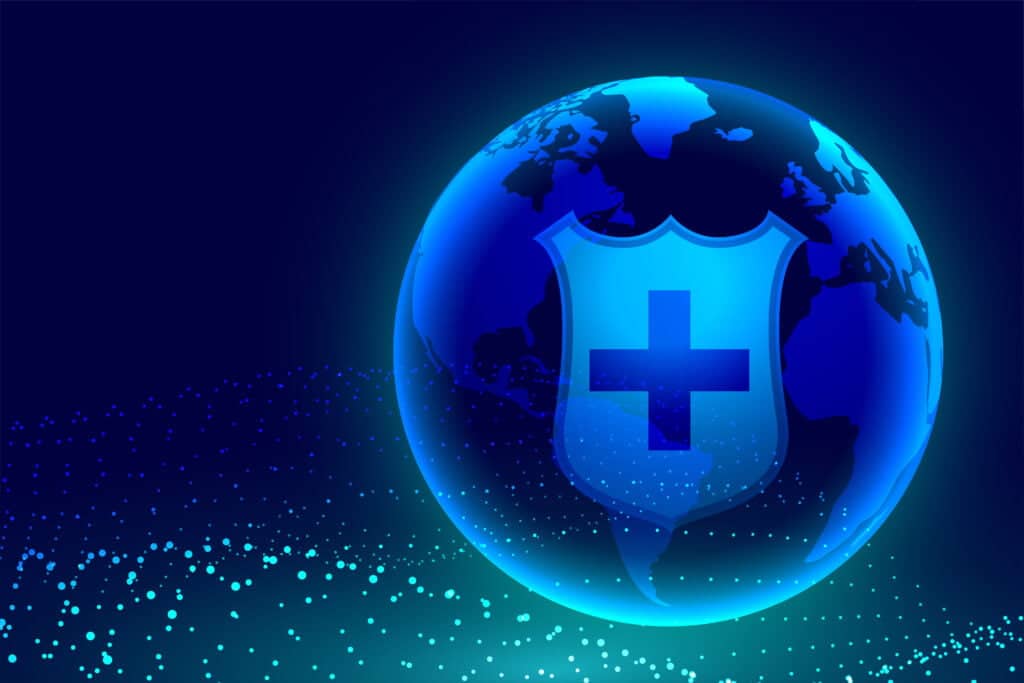The healthcare industry is one of the most targeted industries for cyber-attacks. Healthcare organizations and hospitals hold a wealth of sensitive patient data and intellectual property, making them vulnerable targets for cybercriminals seeking to profit from stolen information.
In this blog, we will explore the cybersecurity challenges in healthcare and provide a comprehensive guide for healthcare organizations to protect themselves against cyber threats.
The Current State of Cybersecurity in Healthcare
Cyber-attacks on healthcare organizations have been on the rise over the past five years, with a 42% increase in attacks reported in 2020 alone. Healthcare organizations are attractive targets because they hold sensitive personal and medical information that can be used for identity theft, financial fraud, and ransomware attacks. Moreover, the COVID-19 pandemic has further exposed vulnerabilities in healthcare cybersecurity, as healthcare organizations have increasingly relied on digital technologies to deliver care and manage patient data.
Types of Cybersecurity Threats in Healthcare

Cybersecurity threats have become a growing concern in the healthcare industry. With the increasing use of technology and electronic medical records, healthcare organizations have become more vulnerable to cyber-attacks. Here, we’ll discuss the cybersecurity breaches in healthcare that industry providers face.
-
Ransomware Attacks
Ransomware is a type of malicious software that encrypts the files on a computer system and demands payment in exchange for the decryption key. In the healthcare industry, ransomware attacks can be particularly devastating as they can prevent healthcare providers from accessing critical patient data. These attacks can also lead to data breaches, which can result in the theft of patient data.
The healthcare sector is a primary target for ransomware attacks, with a report by IBM Security showing that the healthcare industry suffered the highest number of cyber attacks in 2020, with ransomware accounting for 80% of those attacks.
-
Phishing Attacks
Phishing attacks involve the use of fraudulent emails, websites, or text messages to trick individuals into providing sensitive information. Healthcare providers are often targeted by phishing attacks as cybercriminals seek to gain access to patient data, financial information, or other sensitive data. Phishing attacks can also be used to gain access to healthcare provider networks, which can be used to launch more advanced attacks.
According to a report by the Anti-Phishing Working Group (APWG), there were 222,163 unique phishing attacks in Q1 2021, an increase of 11.5% compared to Q4 2020.
-
Malware Attacks
Malware attacks are the use of malicious software, such as viruses or Trojan horses, to gain unauthorized access to a computer system. These attacks can be used to steal sensitive data, including patient information, financial information, or other confidential information. Malware attacks can also be used to gain access to healthcare provider networks, which can be used to launch more advanced attacks.
According to a report by Cybersecurity Ventures, a new piece of malware is released every 14 seconds, and the number of malware attacks is expected to reach 100 million by the end of 2025.
-
Insider Threats
Insider threats occur when an individual with authorized access to a healthcare provider’s network or systems intentionally or unintentionally causes harm. This can include stealing patient data, selling sensitive information, or installing malware or viruses. Insider threats can be difficult to detect as the individual responsible may have legitimate access to the system.
Insider threats, where an employee or contractor with access to sensitive information intentionally or accidentally causes a data breach, are a significant concern. According to a report by Ponemon Institute, 60% of organizations experienced an insider-related incident in the past year.
-
Denial of Service (DoS)
Attacks Denial of Service (DoS) attacks involve the flooding of a computer system with traffic, making it difficult or impossible for legitimate users to access the system. In the healthcare industry, DoS attacks can prevent healthcare providers from accessing critical patient data, causing significant disruptions to patient care.
These threats on cybersecurity in healthcare automatically stresses upon the importance of implementing or prioritizing cybersecurity in hospitals and healthcare institutes.
Importance of cybersecurity in healthcare

Cybersecurity is essential in healthcare because of the sensitive nature of the information handled by healthcare providers and the potential impact of a security breach. That said, here are the reasons why cybersecurity is important in healthcare.
-
Protecting Sensitive Information
Healthcare providers deal with some of the most sensitive information, including medical histories, test results, and personal identification details. Cybercriminals target healthcare organizations because they can sell this information on the dark web or use it for identity theft. By implementing robust cybersecurity measures, healthcare organizations can protect sensitive information and prevent breaches.
-
Maintaining Patient Trust
Patients trust healthcare providers to keep their information secure. A breach can have devastating consequences, including a loss of trust and reputation damage. Patients may also become hesitant to share their personal information with healthcare providers, which can impact their care.
-
Complying with Regulations
Healthcare organizations are subject to various regulations, including the Health Insurance Portability and Accountability Act (HIPAA). HIPAA requires healthcare providers to protect patient information and sets out specific standards for data security. Failure to comply with HIPAA can result in significant fines and reputational damage.
-
Protecting Medical Devices
Connected medical devices, such as insulin pumps and heart monitors, have revolutionized healthcare, but they also create new vulnerabilities. Cybercriminals can exploit these vulnerabilities to gain access to sensitive information or even take control of the device itself. By implementing robust cybersecurity measures, healthcare providers can protect patients from potential harm.
Best practices for implementing cybersecurity in healthcare

With the increasing cybersecurity threats in hospitals, healthcare providers must take proactive measures to ensure the security of their patients’ data. Here, will discuss the best practices for implementing cybersecurity in healthcare and the steps that healthcare providers can take to protect their patients’ data.
-
Conduct a Risk Assessment
A risk assessment is a comprehensive evaluation of the organization’s cybersecurity posture. The assessment identifies potential threats and vulnerabilities, assesses the likelihood of an attack, and evaluates the impact of a successful attack on the organization’s operations, reputation, and patients’ data. A risk assessment is an ongoing process that should be updated regularly to reflect changes in the organization’s infrastructure and new threats that may emerge.
-
Develop a Cybersecurity Policy
A cybersecurity policy is a set of guidelines and procedures that outline the organization’s approach to cybersecurity. The policy should be comprehensive and cover all aspects of cybersecurity, including data protection, access control, incident response, and employee training. The policy should be regularly reviewed and updated to reflect changes in the threat landscape and the organization’s infrastructure.
-
Implement Access Control Measures
Access control measures are essential for protecting patient data from unauthorized access. Healthcare providers should implement role-based access control (RBAC) to ensure that employees only have access to the data they need to perform their job functions. Multi-factor authentication (MFA) should also be implemented to add an additional layer of security to the authentication process. MFA requires users to provide two or more forms of authentication, such as a password and a biometric factor like a fingerprint or facial recognition.
-
Encrypt Data
Encryption is the process of converting data into a code that can only be decoded with a key. Encryption is essential for protecting patient data during transmission and storage. Healthcare providers should implement encryption protocols for all data in transit and at rest. Data encryption should be enforced at all levels of the organization, from the endpoint devices to the cloud storage.
-
Implement Incident Response Procedures
Incident response procedures are essential for minimizing the impact of a cyber-attack. Healthcare providers should have a detailed incident response plan that outlines the steps to take in the event of a security breach. The incident response plan should include a process for detecting and reporting security incidents, containment measures to prevent the spread of the attack, and procedures for restoring systems and data after the attack.
-
Regularly Train Employees
Employees are often the weakest link in cybersecurity. Healthcare providers should regularly train employees on cybersecurity best practices to reduce the risk of human error. Training should include information on how to identify and report security incidents, how to create strong passwords, and how to recognize phishing attempts.
Cybersecurity is essential in healthcare to protect sensitive information, maintain patient trust, comply with regulations, and protect medical devices. Healthcare providers must implement robust cybersecurity measures. By doing so, they can ensure that patient information is protected, and their reputation remains intact. Luckily, there are some cybersecurity solutions that can help in safeguarding the health sector’s confidential data.
Also Check: IoT in Healthcare: A Comprehensive Guide
Cybersecurity services for the Healthcare Industry

In today’s interconnected world, cybersecurity is of paramount importance for all industries, and the healthcare industry is no exception. In fact, given the sensitive and confidential nature of healthcare data, the healthcare industry is a prime target for cyber-attacks. This means that healthcare organizations need to be proactive in implementing cybersecurity solutions to safeguard their patients’ data and maintain the integrity of their systems. Now, we will explore some of the cybersecurity solutions that healthcare organizations can implement to ensure the security of their systems.
-
Access Controls and User Management
Access controls are one of the most fundamental cybersecurity solutions that healthcare organizations should implement. This includes controlling who has access to sensitive data and ensuring that only authorized personnel are granted access. Healthcare organizations should also implement a user management system to ensure that employee accounts are created, updated, and deleted as required. This ensures that access to sensitive data is controlled, and user accounts are not left open, making them vulnerable to cyber-attacks.
-
Multi-factor Authentication (MFA)
Multi-factor authentication (MFA) is a cybersecurity solution that adds an additional layer of security to the login process. This solution requires users to provide multiple forms of identification before granting access. These may include password, smart card details or biometric data. Implementing MFA is an effective way of reducing the risk of unauthorized access to sensitive data, and it is a recommended best practice for all healthcare organizations.
-
Encryption
Encryption is another critical cybersecurity solution that healthcare organizations should implement. This involves the use of algorithms to scramble data, making it unreadable to unauthorized parties. Encryption can be applied to both data at rest (stored data) and data in transit (data being transmitted over a network). Encryption ensures that even if data is intercepted during transmission or storage, it will remain unreadable, protecting it from cyber-attacks.
-
Firewalls and Intrusion Detection/Prevention Systems
Firewalls are a fundamental cybersecurity solution that healthcare organizations should implement. A firewall is a type of network security device that keeps track of and manages all inbound and outbound network traffic. It acts as a barrier between a trusted network and an untrusted network (such as the internet) and filters traffic based on predetermined rules. Intrusion detection and prevention systems (IDPS) are another cybersecurity solution that can be used in conjunction with firewalls. IDPS can identify and block malicious traffic, ensuring that sensitive data is not compromised.
-
Regular Security Assessments and Testing
Regular security assessments and testing are critical cybersecurity solutions that healthcare organizations should implement. These assessments and tests help to identify vulnerabilities in the system and potential areas for improvement. Regular assessments and testing should be conducted to ensure that all systems are up-to-date and secure. These assessments and testing can be performed internally or by third-party organizations.
-
Employee Education and Training
Employee education and training are critical cybersecurity solutions that healthcare organizations should implement. Healthcare employees should be trained on cybersecurity best practices, including how to recognize and report suspicious activity. Employees should also be aware of the risks associated with phishing scams and how to avoid them. This education and training will help to reduce the risk of human error leading to a cybersecurity breach.

Wrapping up
cybersecurity is a critical concern for the healthcare industry, given the sensitive nature of healthcare data. Healthcare organizations should implement a range of cybersecurity solutions and best practices to ensure the security of their systems, protection of their patients’ data from cyber-attacks, and a better future of cybersecurity in healthcare. Contact a cybersecurity service providers today to protect your healthcare infrastructure from threats.
Frequently Asked Questions
Cybersecurity is crucial in healthcare to protect sensitive patient data, prevent data breaches, safeguard medical devices, and ensure the uninterrupted delivery of critical healthcare services. It helps maintain patient privacy, protects against potential cyberattacks, and ensures the overall safety and trustworthiness of healthcare systems and technologies.
Cybersecurity is more critical in healthcare due to several reasons:
-
Sensitive Data: Healthcare systems store highly sensitive patient information, including medical records and personal data, making them prime targets for cyberattacks.
-
Patient Safety: A breach in healthcare systems could lead to patient harm if attackers manipulate medical devices or disrupt critical services.
-
Regulatory Compliance: Healthcare organizations must adhere to strict data protection regulations, such as HIPAA (Health Insurance Portability and Accountability Act), with severe consequences for non-compliance.
-
Increasing Cyber Threats: The healthcare industry has experienced a surge in cyberattacks, including ransomware, phishing, and data breaches, highlighting the urgent need for robust cybersecurity measures.
-
Trust and Reputation: A cybersecurity incident can erode patient trust and damage the reputation of healthcare providers, leading to potential financial and legal repercussions.
-
Interconnected Systems: Healthcare relies on interconnected technologies, making it more susceptible to cascading effects if one system is compromised.
To prevent cybersecurity attacks in healthcare:
-
Implement strong access controls: Restrict access to sensitive patient data and ensure only authorized personnel can access it.
-
Regular staff training: Educate employees about cybersecurity best practices, including identifying phishing emails and handling sensitive data.
-
Keep software updated: Maintain up-to-date antivirus, firewalls, and software patches to protect against known vulnerabilities.
-
Data encryption: Encrypt all patient data in transit and at rest to safeguard it from unauthorized access.
-
Network security: Deploy robust network security measures like intrusion detection systems and secure Wi-Fi networks.
-
Backup and disaster recovery: Regularly back up data and create disaster recovery plans to ensure quick restoration in case of an attack.
-
Conduct security assessments: Regularly assess your systems for vulnerabilities and address any weaknesses promptly.
-
Multi-factor authentication: Use multi-factor authentication for user logins to add an extra layer of security.
-
Incident response plan: Develop a clear incident response plan to quickly and effectively address cybersecurity breaches.
-
Vendor security evaluation: Ensure third-party vendors meet security standards before granting them access to patient data.
Cybersecurity is the practice of protecting computer systems, networks, and data from unauthorized access, attacks, damage, or theft. It involves various technologies, processes, and practices to safeguard against potential threats. Here’s how it works in a nutshell:
-
Risk Assessment: Organizations assess their digital assets and potential vulnerabilities to identify and prioritize potential risks.
-
Security Measures: Implementing a combination of technical and non-technical measures like firewalls, encryption, access controls, and security policies to protect against threats.
-
Monitoring and Detection: Employing tools and techniques to detect suspicious activities and potential breaches in real-time.
AI will not replace cybersecurity. Instead, it will augment and enhance cybersecurity practices, helping to detect and mitigate threats more efficiently. Human expertise and oversight will remain critical to address complex and evolving cyber threats.
Measuring cybersecurity risk involves assessing the likelihood of a security incident and its potential impact on an organization. This can be done through the following steps:
-
Identify Assets: Determine the critical assets and data that need protection.
-
Threat Assessment: Evaluate potential threats and vulnerabilities that could target those assets.
-
Impact Analysis: Analyze the potential consequences of a successful attack on the assets.
-
Risk Quantification: Assign a numerical value to the probability of an incident and its potential impact.
-
Risk Mitigation: Implement security measures to reduce the identified risks.
-
Continuous Monitoring: Regularly reassess and update the risk analysis as the threat landscape evolves.












